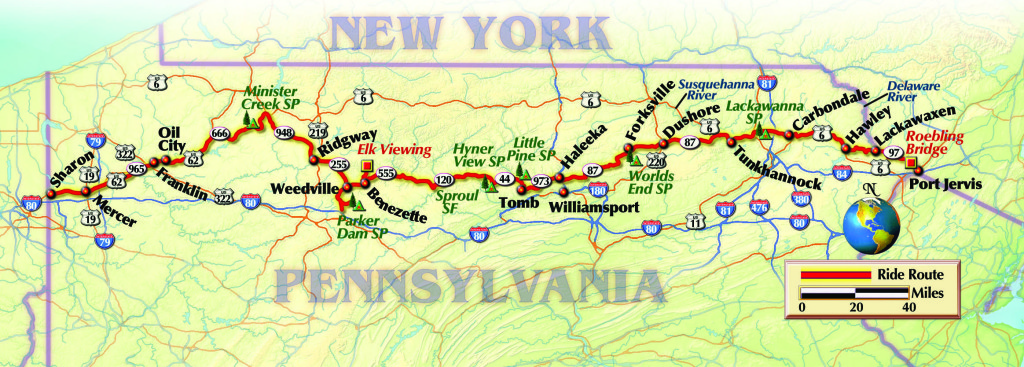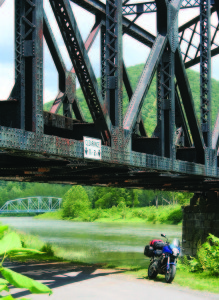There is a perfectly serviceable bridge on Interstate 84 that carries me across the Delaware River from New York into Pennsylvania in seconds. I know. I’ve crossed it many times over the past 28 years.
But not today.
Today is the sort of morning that gives June its good reputation. At the beginning of one of the northern hemisphere’s longest days, the morning’s warmth promises easy comfort, not the weighty humidity of late summer. More importantly, the day, and another after it, are my own. Time to spare is the greatest fortune. Today, I don’t need the expediency of the interstate, so I delay my crossing of the Delaware and aim north on New York Route 97. No way I can come this close and not take another run through that sexy wiggle of cliffside pavement known as Hawk’s Nest. I have to stop for a photo, even though the slant of the morning sun means 97’s most alluring curves are veiled in shadow. The Delaware, far below, is mud-brown and high and pushes past with more haste than usual, thanks to recent rain. No lazy inner-tube drifters on the river today. Just a few more serious kayakers.
Instead of the interstate span, I cross the Delaware on the historic Roebling Bridge, a one-lane oddity that resembles some kind of ancient wooden bobsled run before they invented curves. The truth of it is even stranger than that fiction. The Roebling Bridge was built between 1847 and 1851 to carry water across water. It allowed the old Delaware & Hudson Canal to cross the Delaware River without the sort of disruptions to commerce and occasional gunplay that could result if logs floated down the river by timber companies blocked the canal boats. John A. Roebling designed the structure before going on, more famously, to design the Brooklyn Bridge with his son, Washington.
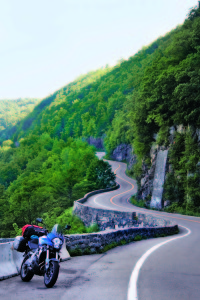
Near the west end of the Roebling Bridge is another unlikely landmark, the Zane Grey Museum. Grey, one of the most popular and wealthy authors of his era, wrote millions of words in the form of novels of the Old West, other books and magazine articles while living here. The stately house in these eastern woodlands seems an odd setting for writing westerns, but its spacious porch certainly is a fine spot to write something. And Grey enjoyed walking down his front lawn to some fine fishing.
I start my crossing of Pennsylvania on Route 590, a two-lane that meanders along the Lackawaxen River a while, then bolts up a mountainside like a fickle goat trail before winding through pine forests. After skirting Scranton, I escape traffic by veering onto Route 87, an appropriately obscure country road leading west. Some many miles later (who’s counting?), I pull off near a spot where the undulating pavement slices through the heart of a farm, cutting between the house and barn. It’s an arrangement you only see on old roads, one that worked better when traffic was horsedrawn, not swooshing through the middle of a working farm at 55 mph.
I’m fiddling with my camera when a guy on a Victory cruiser stops to talk. He’s riding from Chicago to New York on back roads and he tells me about the one and only curve on Route 120 that’s labeled 20 mph and really means it. “I know,” he says. “I went back and rode it three times. Even dragging the footpegs, I couldn’t get through it much faster than 20 mph.”
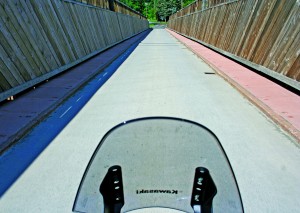
Anyone who stops to ride the same curve three times is in perfect harmony with the mood I’ve set for this crossing of Pennsylvania. Like me, he’s taking his time.
Time, as much as place, is what this trip is really about. Time, or the luxury of it, is the reason I chose the Roebling Bridge instead of the I-84 interstate bridge. For me, this particular ride is long overdue. This one’s personal.
For years, I viewed Pennsylvania as one big rectangular obstacle. Fresh out of college, I got a job in the Hudson Valley of New York that was low on pay and free of prestige. But the country was in a recession that remains a reference point in today’s news stories (“…the unemployment rate is the worst since…”), so I was glad to find any job in my field. Worst of all, because I was required to have a car, I had to trade a perfectly reliable motorcycle for a rust bucket of a car and I began the only motorcycle-less era of my adult life.
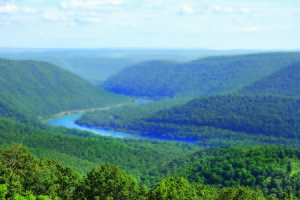
Pennsylvania was the expanse I crossed nonstop each time I needed to go from my new home in the Hudson Valley to my family home in the Ohio Valley. Those crossings of Pennsylvania consisted of the tedium of watching interstate mile markers pass and one episode of despair. I can assure you from personal experience that when your car breaks down on the afternoon of December 24, roughly halfway through a 600-mile trip, options are few. And if the car in question is one for which you traded your motorcycle, the experience doesn’t make you feel better about the transaction.
Back then, even as I plowed through Pennsylvania with blinders on, I knew there had to be more to see out there in the folds of those regimented ridges. Now, decades later, I’m going to find out.
After the Victory rider departs, I take a detour to the end of the world. Actually, Worlds End State Park. The name may be a mistake, however. A spot near here on Loyalsock Creek may have once been called Whirl’s Glen, because of a whirlpool in the stream, and an inaccurate map renamed it Worlds End. Or maybe it was originally Whirls End. Details are sketchy.
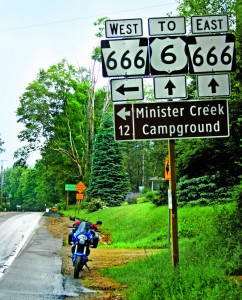
Either way, it’s an idyllic stop. While families picnic on the banks and children splash in the shallows, I chat with a park ranger who asks about my ride. He’d be interested in a new bike, he explains, if his BMW K 100 RT would ever cooperate and give him reason to replace it, but at 90,000 miles it just keeps running, so he rode it to work that morning as usual. As he returns to work, I nab the photo I’ve been planning ever since I spotted the park on my Pennsylvania road map. I’ve always wanted to say I’ve been to the ends of the earth. Now, I have a photo of my bike under the “Worlds End” sign to prove it.
Skirting Williamsport, I ride north on Route 44, a favorite among local riders, through the Sproul State Forest. Clusters of pickups mark the proximity of good fishing holes, where retirees cast away, beginning their work week on a Monday. Spotting the sign for Hyner Run Road, I bank left and follow the bumpy pavement, not quite two full lanes wide, to the entrance to Hyner View State Park. I lean left again and suddenly I’m climbing a smoothly paved, four-mile, dead-end road with no traffic but lots of curves. Ideal. At the end, Hyner View State Park, little more than an overlook built by the Civilian Conservation Corps, offers panoramic views of the West Branch of the Susquehanna River.
This perch, 1,300 feet above the river, is popular among hang gliders who fling themselves off its precipice. I keep my Kawi’s tires planted on pavement as I glide back down the empty road. Chipmunks, bored with their bucolic existence, bolt across my path, tails hoisted for added speed, enjoying a shot of adrenaline as I whoosh by.
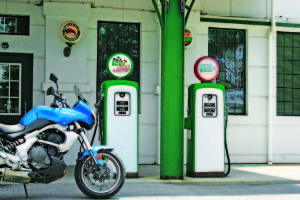
Still meandering west, I follow another three-digit road, Route 555, to the village of Benezette. Here, a roadway encounter with wildlife carries much higher stakes than a brush with suicidal chipmunks, because I’m now in Pennsylvania’s elk country. Elk were common here until the westward expansion in the 1800s eliminated them. In the 20th century, a herd from the Rockies was reintroduced. More recently, reclaimed strip mining land was planted with vegetation elk love to munch. Specially built overlooks provide distant views of these meadows, and along with a few others, I watch the elk begin drifting from the forest for their evening meal.
Dawn comes early in these longest days of June, and an insistent discussion between two crows above my tent at Parker Dam State Park provides an early wakeup call. An hour down the road in the town of Ridgway, I park in front of the Pennsy restaurant, the sort of place that never makes the Michelin guide. The regulars interrupt their talk about horses when they see my bewilderment and assure me that yes, I have to go through the kitchen and down the stairs to reach the restroom. But the pancakes are the size of hubcaps and the coffee’s hot, so I’m satisfied.
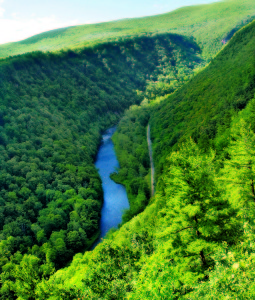
Having gone out of my way to find the world’s end, I now can’t resist taking the devil’s road to the minister’s creek. At an intersection in the Allegheny National Forest, signs point left for both Route 666 and Minister Creek State Park. Damp patches from a morning thunderstorm make bumpy old 666 even more diabolical. Is it just coincidence that the devilishly dark clouds part and the sun emerges when I reach the end of Route 666?
Approaching Pennsylvania’s western edge, one last stop lies ahead: the original Quaker Steak & Lube in downtown Sharon. Yes, Quaker Steak. During the 1974 oil shock, a couple of guys bought a defunct Quaker State gas station and turned it into a cook-your-own steak restaurant, built around a gearhead theme. The cook-your-own part didn’t catch on, but the antique cars and motorcycles used as decor were a hit. Today, QS&L is a chain of restaurants, all of which look, from the outside, like just about any other suburban franchise. Except for the original in Sharon, which still features the old gas pumps and green-and-white motif.
In the lot, a crew is setting up a tent and stage for the weekly Bike Night that is a staple at all QS&L locations. I inadvertently park in the area reserved for an antique bike show. “You’re good for now,” the worker good-naturedly tells me.
It’s true, my Kawi Versys, splattered with bugs and crusty with road spray from Route 666, belongs in no bike show. I claim an outdoor table for a leisurely lunch.
In the end, our motorcycles rust away, our homes pass to other hands. The only thing we really own is our time, and even then, there are many demands upon it. That’s why it’s so valuable. Free time is the wealth that allows me to cross Pennsylvania in two days on triple-digit routes such as 590 and 666 instead of hours on bland interstates. It took me 28 years, but this time I did it right.
[This article was originally published in the March 2012 issue of Rider magazine]
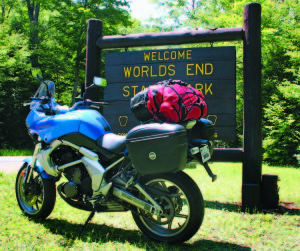 |
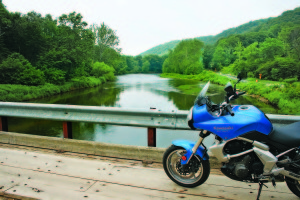 |
